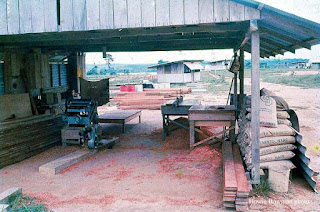No doubt you’ve been following the story
of 17 kidnapped missionaries in Haiti. First, their captors demanded $17 million
ransom, and now they’re threatening to kill the missionaries.
WOW.
That
stirs up horrific memories for us
and for
our colleagues and friends—
all the
people we worked with in Colombia:
memories
of the kidnapping and murder
of Chet Bitterman.
I wrote
about it in my memoir, Please, God, Don’t Make Me Go: A Foot-Dragger’s Memoir.
Glenny Gardner was the first friend my son made when we arrived at our remote outpost
in central Colombia, and he remained a constant friend and playmate. I wrote
this early in my memoir:
“Marxist guerrillas kidnapped Glenny’s
brother-in-law, Chet Bitterman, and murdered him. His story spread throughout
the Western world.. . . . (From Chapter 6, Please, God, Don’t Make Me Go: AFoot-Dragger’s Memoir)
And Chet would not be our only friend
guerrillas murdered.
For our family for three years, for our colleagues
who worked there more than thirty years, for missionaries with other
organizations—anti-American guerrillas were always lurking, sometimes
face-to-face with us, sometimes in the shadows, but always stalking.
Let me tell you more about Chet.
One day during our third year there in
Lomalinda, I heard someone call “knock-knock” at our back door. There stood a
grinning Chet Bitterman.
He had arrived only recently, bringing with
him Brenda, Glenny Gardner’s sister. By then she was all grown up, wife to
Chet, mother to Anna, and trained in Bible translation.
Little did I know that one of God’s most
set-apart servants had stepped into my porch that day.
Never could I, or anyone, have imagined that,
in a few short months, God would use Chet’s kidnapping and murder to advance
Bible translation and heal the long-standing strained relationship between the
Colombian government and our organization.
Here’s how the story unfolded:
On January 19, 1981, seven
masked, armed M-19 guerrillas kidnapped 28-year-old Chet Bitterman and
threatened to kill him unless SIL left the country by February 19.
But our
fellow missionaries had passed legislation stating they would not pay ransom or
give in to blackmail or extortion. Our entire mission agency had the same policy, as
did the Colombian government and other mission agencies because paying a ransom would
encourage more kidnappings around the world.
Chet
understood the need for the policy.
A
year or two before his kidnapping,
he
told his wife, Brenda, something
that
would help her through that unspeakably painful time.
He
had said, speaking of that legislation,
“You
hate to hurt people,
but
it'd be better to sacrifice a few lives if necessary
than
give in to these jokers and encourage them to do it again.”
But,
of course, Chet’s family and our administration wanted to save Chet’s life, so
our director, Will Kindberg, contacted the U.S. Embassy saying that although
SIL wouldn’t pay ransom or give in to demands to leave the country, he might
consider negotiation.
The
official arranged for an experienced negotiator to work with him but, on March
7, 1981, following seven weeks of intense talks, the M-19 shot Chet through the
chest and left his body in a bus.
Will
called Chet’s father in Pennsylvania who, despite his grief, said, “We are sure
you did everything you could do. Do not feel you have failed. We know this is
what God had planned for Chet.”
Before
Chet and Brenda started their assignment in Colombia, Will had met with them in
Dallas and Chet said something Will never forgot. “We are ready to do anything
for God. Anything the Colombia Branch asks us to do. We are willing to go to
the hardest place. If there is something no one else wants to do, we will take
that assignment.”
After
Chet died, Will wrote, “That statement was to come back to me with tremendous
impact. And because I knew he meant it, I was better able to handle probably
the most difficult situation I have ever had to face in my entire life.
“I
still cry when I think of that conversation,” Will said. Recalling Chet’s
willingness to take on a task no one else wanted to do, he said, “He and Brenda
did just that, and were an example to all on how to do it.”
In
an interview on Colombian radio,
Chet’s
father said, “I don’t know what God plans to do
with
the death of my son.
I
guess we’ll just have to wait and find out.”
Though
perhaps no one heard God speak at that moment,
it
was as if He reiterated what He had told Habakkuk:
“Look
. . . and watch—and be utterly amazed.
For
I am going to do something . . .
that
you would not believe, even if you were told.”
(Habakkuk
1:5)
Chet’s
father continued, “Chet had a great love for the Colombian people; he wanted to
tell the [indigenous] about God.
“Now
I’m hoping someone else will go in his place.”
And
someone did.
Wanting
to fill the gap Chet’s death created,
twice
as many people applied to Wycliffe U.S.
compared
to previous years, and the trend continued.
Chet’s friends and family buried him in
Lomalinda’s cemetery. Tom Branks spoke of him in ways few could have—Tom has a
gifted way with words. You can read his message in Called to Die: The Story of American Linguist Chet Bitterman Slain by Terrorists, by Steve Estes.
A Lomalinda kid, Jonathan Smoak, remembers:
[My brother] Thomas Smoak III, Ron
Ravensbergen, and I dug his grave. I remember my mind wandering everywhere
about death and sacrifice as we shoveled away in the hot afternoon sun.
But what I most remember is the sound of the
first shovelfuls of dirt hitting the casket after his body was laid to rest.
The deep thud of dirt on the simple casket seemed so loud and hollow. I got
sick to my stomach when I heard it. It was the sound of finality.
Chet was a good friend, especially during
afternoon soccer games, always smiling, always joking around, and then he was
gone from this earth forever. That was the first time I had ever contemplated
what I wanted to do with my life.
A year later, to demonstrate their
forgiveness,
Chet’s parents flew to Meta,
the departamento (state) in which Lomalinda
is located,
to deliver a gift, an ambulance to help
locals,
especially the poor.
The Bittermans also assured the country’s
people
that because of God’s help,
they felt no hatred toward them.
Those words impressed
top-level government officials, as did the Bittermans’ generous gift, so much
so that the event was a turning point. After meeting with Chet’s parents,
Colombia’s President Turbay voiced his support of our work.
And, in a radical change after years of
animosity, the nation’s press published positive stories on Chet’s parents, the
ambulance, and our work.
“The guerrillas had intended to oust the
[Bible] translators; instead they entrenched them. Almost a decade of negative
press gave way to supportive editorials,” wrote Steve Estes in Called to Die.
After Chet’s death, Estes said, our personnel
“basked in the effusive support that followed from President Turbay.”
In that way, God used Chet’s murder
to open the way for Bible translators
to continue their jobs throughout the nation.
What a shocking, wonderful turnaround for
our work in Colombia!
Indeed, God did something we would not have
believed,
even if we had been told ahead of time!
(Habakkuk 1:5)
But despite new support from the press and
the government, our mission organization remained the target of guerrillas.
During Chet’s captivity, a pipe bomb exploded at the home of one of the
Bogotá-based families, and ongoing terrorist efforts hindered the work of
translators in tribal areas.
And
in 1994, guerrillas abducted our friend and colleague Ray Rising, and, as in
Chet’s case, international news agencies covered Ray’s story, too. Unlike
Chet’s case, Ray’s captors released him after 810 days. Denise Marie Siino
penned his grueling experience in Guerrilla Hostage.
Nevertheless, those intrepid missionaries continued
their work.
In 2004, former M-19 guerrilla Lucy Argüello
Campo traveled to the U.S. to ask Chet’s family and missionary colleagues to
forgive the M-19 for murdering Chet.
Although she joined the group after he died,
she felt compelled to attempt reconciliation after becoming a Christian and
reading Called to Die, and she did so in a tearful, moving series of meetings
in the States. Chet’s friends and family assured Lucy of their forgiveness, and
some even helped finance her trip.
At such desperate, heartbreaking times—kidnapping,
murder of innocent people—we cry out to God, questioning His goodness and His
care. We might even shake a fist at Him.
“How can You let this happen, God?”
But we must recognize that the way we view
situations
might not be the same way God views them.
He can see the big picture, but we see only
snippets.
“For My
thoughts are not your thoughts,
neither are
your ways My ways,” declares the Lord.
“As the
heavens are higher than the earth,
so are My
ways higher than your ways
and My
thoughts than your thoughts.”
(Isaiah
55:8-9)
All we can do is put our trust in God,
the Ruler of all,
the One who holds all things and all people
in His capable, loving hands.
We did so when Chet was kidnapped and
murdered,
and now we do it again
with those 17 missionaries
in Haiti
facing a similar fate.
May God strengthen them for every moment
of every day and night, and may He
have mercy on them and their families.
We are trusting in You, our God,
with all our hearts,
and will lean not on our own understanding . . . .
Proverbs 3:5















